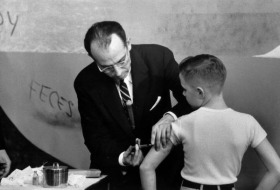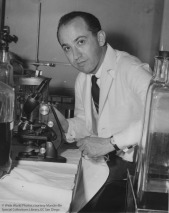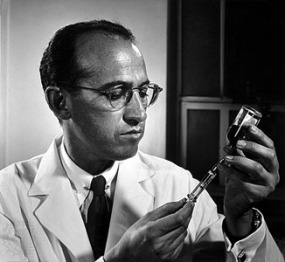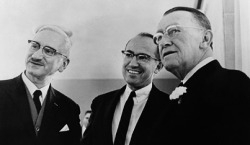Innovation of a Killed-Virus Vaccine

Jonas Salk and a polio pioneer
(umv.edu)
(umv.edu)
In previous vaccines, a weakened virus was used. Salk believed that using a killed virus in the vaccine, like the one he had helped pioneer for influenza, would be more effective.
Salk first killed the poliovirus. The virus was dead but still potent enough to cause the body to create antibodies against the disease. This was an innovative approach for a deadly disease. Limited trials with the vaccine proved that it could raise the antibodies against polio, proving it to be a successful vaccine. Now came the need for wide spread trials.
Salk first killed the poliovirus. The virus was dead but still potent enough to cause the body to create antibodies against the disease. This was an innovative approach for a deadly disease. Limited trials with the vaccine proved that it could raise the antibodies against polio, proving it to be a successful vaccine. Now came the need for wide spread trials.
Vaccine Trials

Salk in his lab
(www.umw.edu)
(www.umw.edu)
The Salk vaccine was tested on a mass trial of 1,830,000 children in 1954. The project was sponsored by a grant of 1.7 million dollars given to Salk and his researchers by the National Foundation for Infantile Paralysis (now the March of Dimes).
The announcement that the vaccine was safe was made in April 1955. The US government then initiated a nationwide inoculation program for first and second graders. Polio and its paralyzing effects became but a memory.
The announcement that the vaccine was safe was made in April 1955. The US government then initiated a nationwide inoculation program for first and second graders. Polio and its paralyzing effects became but a memory.
Salk in His Own Words

Jonas Salk believed the killed-virus vaccine was safer
(www.umw.edu)
(www.umw.edu)
"The reason for pursuing the idea of a killed-virus vaccine is very simple. Before the work on influenza, the effective vaccines were those made with what we call attenuated, or so-called weakened viruses. They have the capacity to infect, but they are less likely to cause disease.
Now sometimes smallpox or vaccinia virus -- which is the same virus that is used to make immunization against smallpox -- would cause serious reactions, and sometimes fatal reactions. There was a rabies vaccine that was made from weakened viruses. There was also a yellow fever vaccine that had been developed that was a weakened virus.
It was not necessary to run the risk of infection, which would have been the case if one were to try to develop an attenuated or weakened polio virus vaccine.
And so it seemed to me the safer and more certain way to proceed. That if we could inactivate the virus that we could move on to a vaccine very quickly. Whereas, if you were dealing with weakened virus, you would have to demonstrate its safety eventually. So, that was the reason and there was a principle that was involved.
You might say a scientific principle, a fundamental principle: choosing and preferring that which the safety which you could control, and the quantities which you could use."
~ Jonas Salk
Now sometimes smallpox or vaccinia virus -- which is the same virus that is used to make immunization against smallpox -- would cause serious reactions, and sometimes fatal reactions. There was a rabies vaccine that was made from weakened viruses. There was also a yellow fever vaccine that had been developed that was a weakened virus.
It was not necessary to run the risk of infection, which would have been the case if one were to try to develop an attenuated or weakened polio virus vaccine.
And so it seemed to me the safer and more certain way to proceed. That if we could inactivate the virus that we could move on to a vaccine very quickly. Whereas, if you were dealing with weakened virus, you would have to demonstrate its safety eventually. So, that was the reason and there was a principle that was involved.
You might say a scientific principle, a fundamental principle: choosing and preferring that which the safety which you could control, and the quantities which you could use."
~ Jonas Salk
Sabin vs. Salk: Attenuated Vaccine vs. Killed-Virus Vaccine

Albert Sabin (left), Jonas Salk (middle),
and Basil O'Connor (right)
(Smithsonian Institute)
and Basil O'Connor (right)
(Smithsonian Institute)
Another doctor, Albert Sabin, was racing to develop his own weakened-virus vaccine. He became an opponent of Salk's vaccine.
"While the large-scale clinical trial with Salk's vaccine went ahead in 1954, Albert Sabin continued developing his live-virus vaccine. Like many researchers of the day, Sabin strongly disagreed with Salk's approach of using injected "killed" virus. He believed that long-term immunity could only be achieved with a live, attenuated--or weakened--virus."
~Smithsonian National Museum of American Health
"While the large-scale clinical trial with Salk's vaccine went ahead in 1954, Albert Sabin continued developing his live-virus vaccine. Like many researchers of the day, Sabin strongly disagreed with Salk's approach of using injected "killed" virus. He believed that long-term immunity could only be achieved with a live, attenuated--or weakened--virus."
~Smithsonian National Museum of American Health
Cutter Tragedy Clouds Innovation
"Only 13 days after the Salk vaccine was declared 'safe and effective', the first reports came in about children who developed poliomyelitis after their vaccination. Most of them were vaccinated with the vaccine of the Cutter Laboratories in Berkeley, California. By June 23rd, 168 confirmed cases of poliomyelitis were diagnosed among the vaccinated, with 6 deaths."
~ The Polio Vaccine, Part 1: The Injected Vaccine Verses the Oral Vaccine
~ The Polio Vaccine, Part 1: The Injected Vaccine Verses the Oral Vaccine